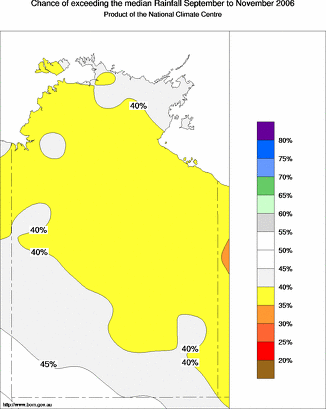| NT Seasonal Rainfall Outlook: probabilities for Spring 2006, issued 23rd August 2006 | |
Odds point to poor start for northern wetThere is a moderate shift in the odds towards below average rainfall over September to November across much of the Northern Territory, the Bureau of Meteorology announced today. The pattern of three-month rainfall odds across Australia is a result of higher than average temperatures in both the Pacific and Indian Oceans, the latter of which has been warming strongly in recent months. 
For the coming three months, the chances of above median rainfall are between 35 and 40% over most of the northeastern two-thirds of NT (see map). So in years with ocean patterns like the current, about six September to November periods out of ten are expected to be drier than average in these parts of the NT, with about four out of ten being wetter. Across remaining parts of the Territory, the chances are between 40 and 50% for the three-month rainfall total to exceed the long-term median. Outlook confidence is related to how consistently the Pacific and Indian Oceans affect Australian rainfall. During September to November, history shows this effect to be moderately consistent across most of the NT (see background information). The Southern Oscillation Index (SOI) was negative for the third straight month in July with a value of −9. This came after readings of −6 in June and −10 in May. The approximate SOI for the 30 days ending 20th August was −16. If history is any guide, the SOI will probably stay negative for the rest of the year. Although a late-developing El Niño event is still a possibility this year, especially considering the SOI, the consensus from computer models is for continued neutral ENSO conditions for the remainder of 2006, but on the warm side of average. Continued Pacific warmth and negative SOI values are generally associated with increased likelihood of below average rainfall in eastern and northern Australia. For routine updates and comprehensive discussion on the latest data relating to ENSO, together with details on what the phenomenon is and how it has affected Australia in the past, please see the ENSO Wrap-Up. | |
Click on the map above for a larger version of the map. Use the reload/refresh button to ensure the latest forecast map is displayed. | |
| More information on this outlook is available from 9.00am to 5.00pm (CST) Monday to Friday by contacting the Climate and Consultancy section in the Bureau's Darwin Office: (08) 8920 3813. | |
THE NEXT ISSUE OF THE SEASONAL OUTLOOK IS EXPECTED BY 26th SEPTEMBER 2006 Corresponding temperature outlook | |
Background Information
|









